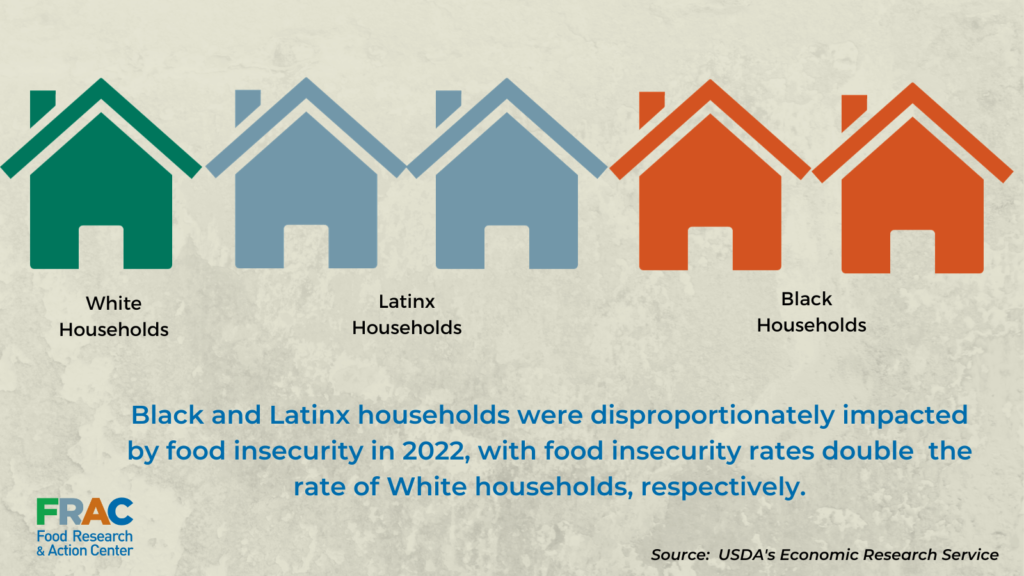November 20, 2023
In recognition of Hunger and Homelessness Awareness Week in November, this blog lifts up opportunities to take action to support millions of families who are experiencing food insecurity and housing instability.
Across the nation, tens of millions of people are struggling to keep up with skyrocketing rents, stagnant incomes, and the end of COVID-19 pandemic-relief supports, which have resulted in growing food insecurity and housing instability. The “rent eats first” and “heat or eat” are phrases anti-hunger stakeholders hear all too often.
The Link Between Food Insecurity and Housing Instability
| Food insecurity is a household-level economic and social condition of limited or uncertain access to adequate food. (USDA, October 2023)
Housing instability encompasses a number of challenges, such as having trouble paying rent, overcrowding, moving frequently, or spending the bulk of household income on housing.(Healthy People 2030) |
About 10.4 million (25.4 percent of renter-occupied units) are spending half or more of their incomes on shelter, leaving families without adequate resources to pay for food. This depletion of family resources to cover rent helps explain the intersection of hunger and housing instability as well as the need for anti-hunger stakeholders to champion policies to support affordable housing.
Households around the nation are experiencing unprecedented threats to their food and housing security — with harms disproportionately affecting Black, Latinx, Native Americans, and other communities of color.
- In 2022, 44.2 million people lived in households that faced food insecurity. Rates of food insecurity were higher for Black (22.4 percent) and Latinx (20.8 percent) households, both double the rate of White non-Latinx households.

- In 2021, the number of cost-burdened renters — defined as those spending more than 30 percent of their income on housing — reached an all-time high at 21.6 million households.
- According to the Housing and Urban Development Annual Homeless Assessment Report, 582,462 people experienced homelessness on a single night in January 2022. Decades of structural racism have created tremendous racial disparities in housing, and that legacy continues to shape and exacerbate housing disparities.
The Harms of Food Insecurity and Housing Instability
Growing research underscores the harms of food insecurity and housing instability to health.
- Both food insecurity and housing instability contribute to children experiencing poorer physical and mental health and lagging behind peers in physical development, educational attainment, and labor market outcomes.[i]
- Food insecurity and housing instability are risk factors for mothers experiencing depression and parenting stress and for adolescents experiencing anxiety and depressive symptoms.[ii]
- Both were associated with an increased risk for cardiovascular disease mortality rate and greater health care cost utilization.[iii]
Households experiencing food insecurity or housing instability engage in coping strategies that can harm health:
- When families are experiencing food insecurity, they often resort to coping strategies: Parents may eat less or eat less nutritiously so children can eat. Household members may forgo medical care or prescriptions. They may be unable to take medicine as properly directed (e.g., rationing it or not taking it with food) because there is no money available.
- Likewise, when the rent eats up most of a household’s paycheck, families have scant money available for other necessities like nutritious food and medical care. The most severely cost-burdened renters spent 38 percent less on food and 70 percent less on health care than their peers without cost burdens in 2020. People experiencing housing insecurity may be forced to live in substandard housing replete with dangerous conditions (e.g., lack of heating, exposure to toxins).
Opportunities to Engage and Take Action
- Join Opportunity Starts At Home (OSAH): OSAH, a multisector coalition, works to build a movement to generate widespread support for federal policies that correct long-standing racial inequities and economic injustices by ensuring quality housing for people with low incomes.
- Advocate for policies to fix the housing crisis: For instance, FRAC, as a member of OSAH’s Steering Committee, is committed to supporting policies that: (1) expand rental assistance for every income-eligible household, with investments in programs like Housing Choice Vouchers; (2) expand the stock of housing that is affordable to households with the lowest incomes, through investments such as the National Housing Trust; and (3) stabilize households by providing emergency assistance to avert housing instability and homelessness through the creation of an Emergency Assistance Fund to aid families experiencing short-term crises that helps stabilize families during times of significant need.
- Connect people experiencing housing instability to the Supplemental Nutrition Assistance Program (SNAP) and other federal nutrition programs: Federal nutrition programs are not only effective in reducing food insecurity, but also in reducing material hardship, which can result in a lower risk of housing instability. Check out FRAC’s SNAP Shelter CAP National fact sheet and Streamlining the New SNAP Time Limit Exemption for People Experiencing Homelessness.
[i] King, Christian, “Food insecurity and housing instability in vulnerable families” (2016). Nutrition and Health Sciences — Faculty Publications. 71. https://digitalcommons.unl.edu/nutritionfacpub/71
[ii] Hatem, C., Lee, C. Y., Zhao, X., Reesor-Oyer, L., Lopez, T., & Hernandez, D. C. (2020). Food insecurity and housing instability during early childhood as predictors of adolescent mental health. Journal of family psychology : JFP : journal of the Division of Family Psychology of the American Psychological Association (Division 43), 34(6), 721–730.
[iii] Parekh, T., Xue, H., Cheskin, L. J., & Cuellar, A. E. (2022). Food insecurity and housing instability as determinants of cardiovascular health outcomes: A systematic review. Nutrition, metabolism, and cardiovascular diseases : NMCD, 32(7), 1590–1608. https://doi.org/10.1016/j.numecd.2022.03.025


